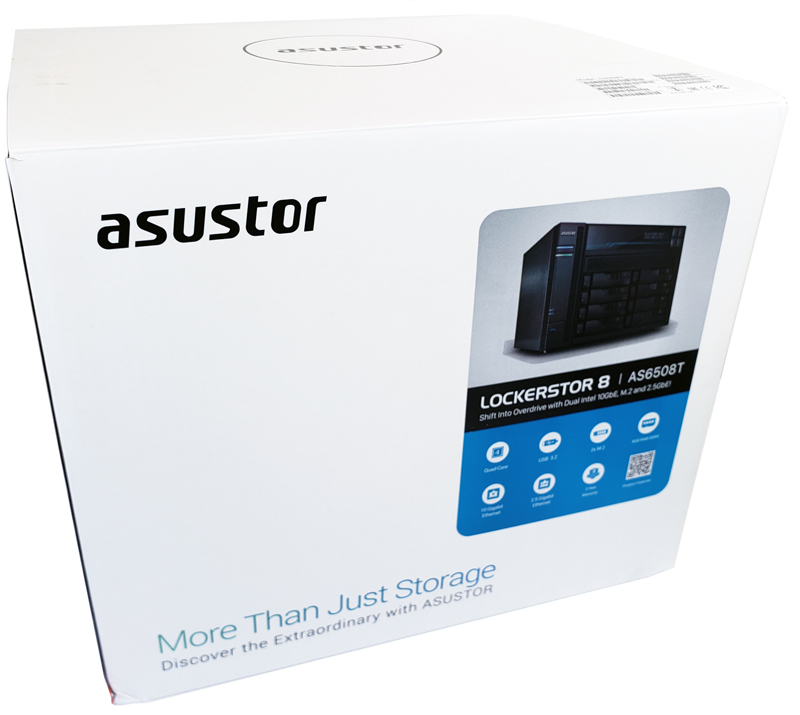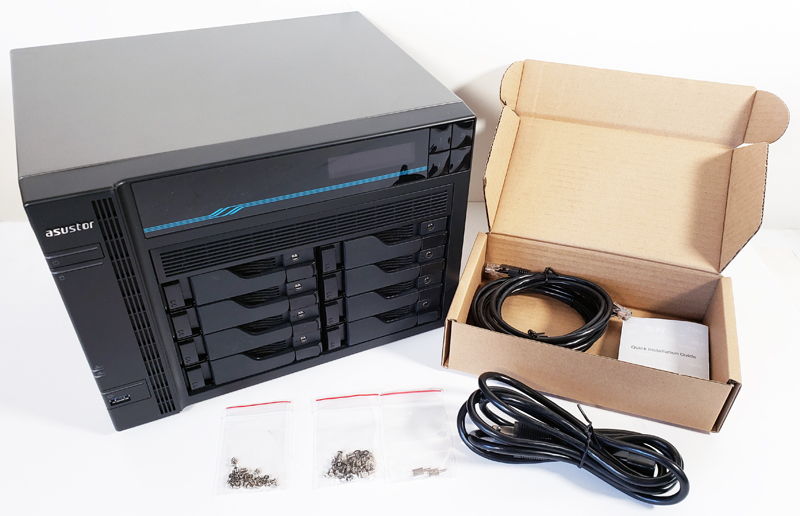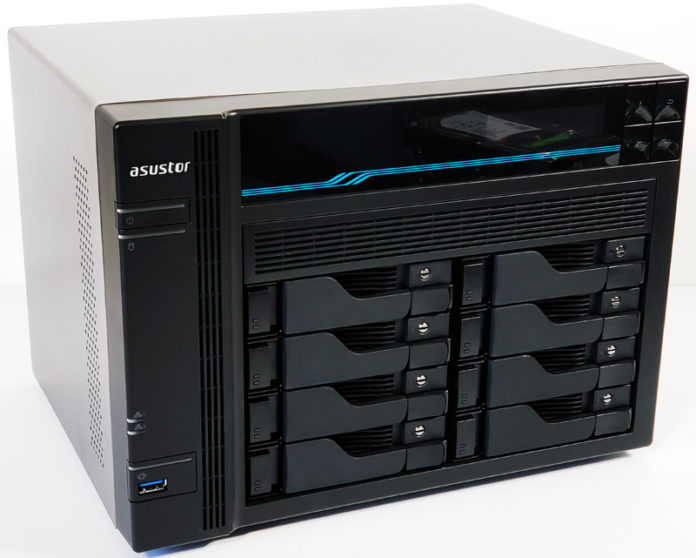Our review of the ASUSTOR Lockerstore 8 AS6508T NAS is going to find something many of our readers want in the 2020s: integrated 10GbE and 2.5GbE. At STH, we reviewed the AS4004T 10GbE 4-Bay NAS also supporting 10GbE. Asustor finished up 2019 with a series of new NAS units that come in two different capacities. Both 8-bay and 10-bay versions are available dubbed the AS6508T and AS6510T. Today we have a review of the AS6508T.
ASUSTOR Lockerstor 8 AS6508T Overview
First off, let us look at the retail box, which is large but not overly heavy. Markings are rather simple, with a single graphic on the front showing basic capabilities.

Here we have taken all items out of the retail box to see what the AS6508T comes with.

Accessories included with the ASUSTOR Lockerstor 8 AS6508T 8-Bay 10GbE NAS are:
- Quick Installation Guide
- AC Power Cord
- 2x RJ-45 LAN CAT5e Cables
- 2x 10GBE LAN Cat 6a Cables
- 1x Package Flat Head Screws for 3.5” HDD’s
- 1x Package Flat Head Screws for 2.5” HDD’s
- 2x M.2 Thumbscrews
Unlike some NAS units in this class, the AS6508T does not use a power brick for power. Instead, it has an internal power supply which is why we do not see that listed as an accessory. It is nice not to have a power brick hanging around at the back of the unit, especially in this segment.
After removing the ASUSTOR Lockerstor 8 AS6508T 8-Bay 10GbE NAS from its packing material, we can now take a look at the NAS.

The enclosure of the ASUSTOR Lockerstor 8 AS6508T 8-Bay 10GbE NAS is solid and of high quality. The overall design is well laid out and easy to get around. At the top, we find an LCD display that shows NAS status and can be used to configure the NAS via 4-buttons at the right side of the display.
The back of the NAS has two RJ-45 10GbE ports along with two RJ-45 2.5GbE LAN ports in red. This is a thoroughly modern design as ASUSTOR omits simple 1GbE ports instead opting to have higher speed ports throttle down to the lower negotiated speed if required. Now that there are more multi-gig switches in the market such as what we saw in our recent Netgear MS510TX review it is great to see the device ecosystem pick up newer standards. This has one of the most modern networking port ensembles in the 8-bay NAS market today.

Two large fans provide HDD cooling and there is also a small fan for PSU cooling needs. We also see a USB 3.0 port that matches the one on the front of the NAS.
The unit itself is powered by an Intel Atom C3538 processor which is a modern quad-core Intel-based embedded SoC. Running at 2.1GHz and with 8MB of cache, this is a solid option for this class of NAS. It is also how ASUSTOR is achieving the modern NIC mix. An Intel Atom C3538 natively supports two 10GbE plus two 2.5GbE MACs natively. Other vendors use less expensive PHYs to save a few pennies and expose the 2.5GbE NICs as only 1GbE. Here, the AST6508T is making the most of the Intel SoC.
Let us move on to see how to install hard drives into our unit.
ASUSTOR Lockerstor 8 AS6508T Drive Installation
Each drive bay can accommodate either a 3.5inch or 2.5inch hard drive or solid-state drive with capacities up to 16TB in size for a total of up to 128TB raw capacity for the AS6508T. The drive trays are not tool-less and require each HDD to be securely mounted into the tray by screws. We hope that these become tool-less designs in the next iteration.

HDDs are then inserted into the NAS and locked into place. The HDD rails allowed the HDDs to slide in easily, some NAS we have found miss-alignments might happen and force an HDD reinsertion. The locking mechanism is also solid, a system with push-button to unlock and lock the tray and also key lockable. The HDD trays are perhaps the best we have seen and provide good security to prevent unauthorized users from kicking drives out and walking away with them.

At the back of the AS6508T, we find three screws that hold the outer case in place. Removing these allows the lid to slide off and gain access to the insides. On the left side of the AS6508T, we find two DDR4 SODIMM memory slots for upgrading needs. Only one is filled in our test unit leaving the other for expansion.

At the top of the AS6508T, we find the two M.2 NVMe slots where cache drives can be installed. In this class of NAS, having M.2 NVMe cache SSD bays is becoming a must-have feature.

A quick word here on customization. One can see that the unit is built with the entire system in mind. Small features like aligning the stand-offs for the M.2 drives above the PCIe riser require tight design integration to pull off. These are some of the benefits that one can see over solutions that utilize off-the-shelf chassis and mITX motherboards.
Let us take a look at setting up the AS6508T software before moving on to testing.





But does it support ZFS? Looks like it uses Btrfs instead…
I’m tempted to downsize, but I’m not giving up ZFS.
the test drives were the 8x 4TB Iron wolves?
what RAID config were they in?
@Mark: on page 2 there is a photo in which it say raid6.
You say “We did not get to test the unit with NVMe caching which may have helped the unit’s perf”…
Why ???
First you say this is a must have feature. Later you list the NVMe drive in the test configuration.
Then you don’t use it?
What’s the point of these tests then?
I haven’t seen anything about power consumption which is, in my opinion, a key parameter for consumers.
Could you elaborate this point please ?
I support an update to this review with NVMe caching.
I support an update to this review with power consumption.
I think this article was perhaps sponsored by Asustor..
horizonbrave – it was not. Everything on STH is editorially independent and we only accept advertising through 3rd party agencies (Google, Amazon, and some smaller ones)
” NVMe caching is a must have feature”
…
“We did not get to test the unit with NVMe caching”
Kinda pointless to review this then isn’t it? Why not wait until you CAN test it. I’m sure STH makes enough ad revenue to buy two NVMe drives. Might want to buy some Kill-A-Watt’s while your at it too.